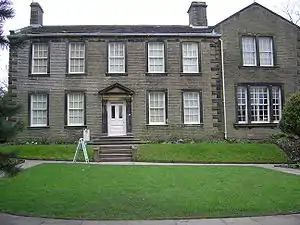Haworth
Haworth (/ˈhaʊ.ərθ/)[2] is a village in City of Bradford, West Yorkshire, England,[3][4] in the Pennines, 3 miles (5 km) southwest of Keighley, 10 miles (16 km) west of Bradford and 10 miles (16 km) east of Colne in Lancashire. The surrounding areas include Oakworth and Oxenhope. Nearby villages include Cross Roads, Stanbury and Lumbfoot.
| Haworth | |
|---|---|
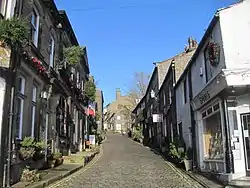 Main Street | |
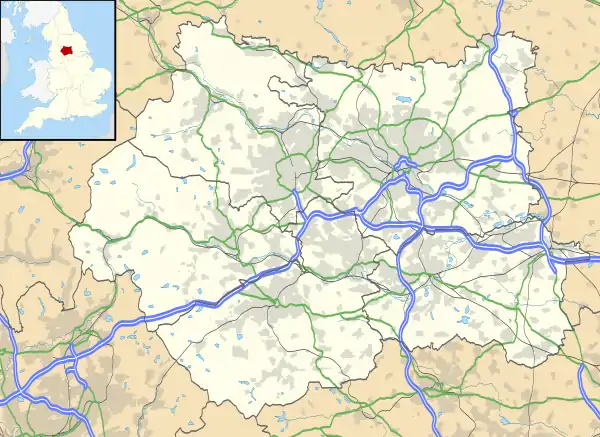 Haworth Location within West Yorkshire | |
| Population | 6,379 (2011 census)[1] |
| OS grid reference | SE030372 |
| • London | 180 mi (290 km) SSE |
| Civil parish | |
| Metropolitan borough | |
| Metropolitan county | |
| Region | |
| Country | England |
| Sovereign state | United Kingdom |
| Post town | KEIGHLEY |
| Postcode district | BD22 |
| Dialling code | 01535 |
| Police | West Yorkshire |
| Fire | West Yorkshire |
| Ambulance | Yorkshire |
| UK Parliament | |
Haworth is a tourist destination known for its association with the Brontë sisters and the preserved heritage Keighley and Worth Valley Railway.
History
Haworth is first mentioned as a settlement in 1209.[5] The name may refer to a "hedged enclosure" or "hawthorn enclosure".[6] The name was recorded as "Howorth" on a 1771 map.
Governance
Haworth is part of the civil parish of Haworth, Cross Roads and Stanbury,[7] which in turn is part of the Bradford Metropolitan District Council, one of the five metropolitan boroughs of West Yorkshire.[8]
Between 1938 and 1974 Haworth was part of the Municipal Borough of Keighley and before that it had been a civil parish and urban district in its own right.
Geography
Haworth is in the Worth Valley amid the Pennines.[9] It is 212 miles (341 km) north of London, 43 miles (69 km) west of York and 9 miles (14 km) west of Bradford.
Economy
Tourism accounts for much of the local economy, with the major attractions being the heritage railway and Brontë Parsonage Museum.[10] In Haworth there are tea rooms, souvenir and antiquarian bookshops, restaurants, pubs and hotels including the Black Bull, where Branwell Brontë's decline into alcoholism and opium addiction allegedly began.[11][12] Haworth is a base for exploring Brontë Country, while still being close to the major cities of Bradford and Leeds.
On 22 November 2002 Haworth was granted Fairtrade Village status.[13] On 21 October 2005, Haworth Fairtrade officially signed an agreement to twin with Machu Picchu in Peru.[14]
Culture
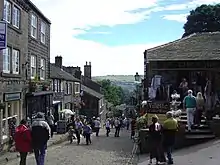
Haworth's traditional events were an annual service at Haworth Spa and the rush bearing. Spa Sunday died out in the early 20th century and the rush bearing ceremony has not been held for many years. A modern event organised by the Haworth Traders' Association is "Scroggling the Holly" which takes place in November.[15] Bands and Morris men lead a procession of children in Victorian costume following the Holly Queen up the cobblestones to a crowning ceremony on the church steps. She unlocks the church gates to invite the spirit of Christmas into Haworth. Father Christmas arrives bringing glad tidings.[16]
The first Haworth Arts Festival took place in 2000 and was repeated in 2001, but ceased. It was revived in 2005 as a festival combining performing and visual arts and street performance.[17] The festival has community involvement and uses local professional and semi-professional musicians, artists and performers and a larger name to headline each year. It has provided a stage for John Cooper Clarke and John Shuttleworth. The festival has expanded across the Worth Valley outside Haworth and is held on the first weekend in September.
Haworth Band is one of the oldest secular musical organisations in the Keighley area.[18] History records indicate that there was a brass band at Ponden, close by in 1854 with a body of excellent performers. It was founded by John Heaton who lived at Ponden. The band played at a celebration in Haworth at the conclusion of the Crimean War. "Over the years the world of brass band music went from strength to strength, during which time the Haworth Band went with it."[19]
Every year the village hosts a 1940s weekend where locals and visitors don wartime attire for a host of nostalgic events.[20]
From 1971 to 1988, 25 and 27 Main Street housed the Haworth Pottery where Anne Shaw produced hand-thrown domestic stoneware derived from the arts & crafts tradition. She exhibited widely in the UK and USA in public and private exhibitions and received an arts association award for her ceramic sculptures. Her husband, Robert Shaw, depicted life (and prominent residents) in the village in the 1970s and 80s, in two collections of satires, The Wrath Valley Anthology, 1981, and Grindley's Bairns, 1988, praised by The Times Literary Supplement.
Community facilities
On 13 January 2009, it was announced that a permanent library would be established in the village, replacing the mobile service which visits the village once a week. Haworth last had its own library in 1978.[21]
Landmarks
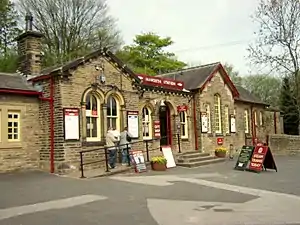
Haworth railway station is part of the Keighley and Worth Valley Railway, an authentic preserved steam railway.
The 43 miles (69 km) long Brontë Way leads past Lower Laithe Reservoir, Stanbury to the Brontë waterfalls, the Brontë Bridge and the Brontë Stone Chair in which (it is said) the sisters took turns to sit and write their first stories. It then leads out of the valley and up on the moors to Ponden Hall (reputedly Thrushcross Grange in Emily Brontë's Wuthering Heights) and Top Withens, a desolate ruin which was reputedly the setting for the farmstead Wuthering Heights. Top Withens can also be reached by a shorter walking route departing from the nearby village of Stanbury.
Transport
Haworth is served by Keighley Bus Company rural bus service which provides links to the main local town of Keighley and the local villages of Oxenhope, Stanbury, Oakworth and Denholme. There is also a service to Hebden Bridge. Evening and Sunday services are partly paid for by Metro.
Central North Street Car Park Haworth, formerly Changegate Car Park, has been subject of a Channel 4 television documentary "The Yorkshire Clamper", regarding their tactics.[22][23]
Education
Haworth Primary School on Rawdon Road is the only school in the village and takes children from age 3 to 11.[24] Children from 12 to 18 attend secondary schools outside the village at Beckfoot Oakbank in Keighley and Parkside School in Cullingworth.[25]
Religious sites
St Michael and All Angels' Church is situated on Church Street, next to the parsonage. It is part of the Church of England Deanery of Craven.[26]
Baptists in the area met in a barn at the bottom of Brow Road in 1785. They subsequently moved to Hall Green Baptist Church at the junction of Bridgehouse Lane and Sun Street.[27]
Sport
Haworth Cricket Club was established in 1887 as Haworth Wesleyan Cricket Club and were members of the English Cricket Board.[28] They had a permanent ground north west of the village centre, but the club was closed down in 2015.[29] Haworth West End Cricket Club was formed in 1900 as the Haworth West Lane Baptist Cricket Club.[30]
On 6 July 2014, Stage 2 of the 2014 Tour de France from York to Sheffield, passed through the village.[31]
Notable people
The Brontë sisters were born in Thornton near Bradford, but wrote most of their novels while living at Haworth Parsonage when their father was the parson at the Church of St. Michael and All Angels. In the 19th century, the village and surrounding settlements were largely industrialised, which put it at odds with the popular portrayal in Wuthering Heights, which only bore resemblance to the upper moorland that Emily Brontë was accustomed to.[32] The Parsonage is now a museum owned and maintained by the Brontë Society.
Filmography
Haworth and Haworth railway station have been used as settings for numerous period films and TV series, including The Railway Children (starring Jenny Agutter), Yanks (starring Richard Gere and Vanessa Redgrave), and Alan Parker's film version of Pink Floyd's The Wall (starring Bob Geldof). It also featured in "Wild Child" (starring Emma Roberts), and "The Souk" (a high-class vintage shop) was depicted as a charity shop.
In 2016 the BBC drama To Walk Invisible was shot in and around Haworth and included a full-scale replica of the Brontë Parsonage, Old School Rooms and Haworth Church at the time of the Brontës on nearby Penistone Hill.
Twinning
References
- UK Census (2011). "Local Area Report – Haworth Built-up area (1119884265)". Nomis. Office for National Statistics. Retrieved 27 March 2018.
- "Haworth". Collins English Dictionary. HarperCollins. Retrieved 27 July 2019.
- "Haworth - Bradford | Welcome to Yorkshire". www.yorkshire.com. Retrieved 14 May 2019.
- "Discover Haworth and Brontë Country". www.visitbradford.com. Retrieved 14 May 2019.
- "Haworth Village – Visiting Haworth – England". Archived from the original on 16 May 2011. Retrieved 10 August 2010.
- Ekwall, Eilert (1960). The concise Oxford dictionary of English place-names (4 ed.). Oxford: Clarendon Press. p. 227. ISBN 0-19-869103-3.
- "City of Bradford Metropolitan District Council – Parish and town councils". Archived from the original on 18 December 2010. Retrieved 5 August 2010.
- Chrystal, Paul (2017). The Place Names of Yorkshire (1 ed.). Catrine: Stenlake. p. 100. ISBN 9781840337532.
- "Haworth Conservation Area Assessment" (PDF). bradford.gov.uk. April 2003. p. 5. Retrieved 27 March 2018.
- Winn, Christopher (2010). I never knew that about Yorkshire. London: Ebury. pp. 121–123. ISBN 978-0-09-193313-5.
- Dewhirst, Ian (18 April 2013). "The Black Bull in Haworth just after the Brontes". Keighley News. Retrieved 27 March 2018.
- Jordison, Sam (10 June 2009). "The Brontës are alive and unwell in Haworth". The Guardian. Retrieved 27 March 2018.
- "Fair traders win award". Telegraph & Argus. Archived from the original on 11 February 2009. Retrieved 24 September 2007.
- "Andes show boosts International link". Telegraph & Argus. Archived from the original on 11 February 2009. Retrieved 24 September 2007.
- "Scroggling the Holly". bronte-country.com. Retrieved 13 March 2017.
- Knights, David (6 December 2013). "Haworth's 'scroggling the holly' is biggest for many years". Keighley News. Retrieved 27 March 2018.
- "Haworth Arts Festival". Archived from the original on 22 January 2013. Retrieved 6 July 2012.
- "The Haworth Band – History". Archived from the original on 10 March 2012. Retrieved 5 August 2010.
- Internet Bandsman's Everything Within, "Archived Histories of Brass Bands", Haworth Band. Retrieved 17 February 2017.
- Haworth 1940s Weekend 2016, unknown 2016 date. Retrieved 17 February 2017.
- Evans, Fiona (13 January 2009). "Library hope for literary village". Yorkshire Post. Retrieved 7 February 2009.
- Wollaston, Sam (4 September 2009). "Last night's TV: The Yorkshire Clamper". The Guardian. Retrieved 30 November 2016.
- "Clamping firm "worst in UK"". BBC News. 26 November 2003. Retrieved 2 July 2017.
- "Ofsted – Haworth primary school". Archived from the original on 17 January 2010. Retrieved 9 August 2010.
- "Haworth Village Local Information – Secondary schools". Archived from the original on 13 June 2011. Retrieved 21 August 2010.
- "St Michael & All Angels, Haworth". Retrieved 5 August 2010.
- "Hall Green Baptist Church – History". Archived from the original on 9 February 2011. Retrieved 5 August 2010.
- "Haworth Cricket Club". Retrieved 14 August 2010.
- Nutting, Asher (24 July 2017). "Haworth West End: No cricket club but a thriving ground". Cricket Yorkshire. Retrieved 15 June 2019.
- "Haworth West End Cricket Club – History". Retrieved 14 August 2010.
- "Tour de France Stage 1". Archived from the original on 25 July 2014. Retrieved 15 July 2014.
- Fraser, Rebecca (1993). "The Brontës". In Marsh, Kate (ed.). Writers and Their Homes. Hamish Hamilton. p. 41. ISBN 0-241-12769-6.
External links
| Wikivoyage has a travel guide for Haworth. |
| Wikimedia Commons has media related to Haworth. |
- Haworth - in Bronte Country
- Haworth Village - Yorkshire
- "Haworth" Haworth Online
- "Welcome to Brontë Country", Eagle Intermedia's Bronte Country
- Haworth at Curlie
- "Discover Haworth and Brontë Country", Visit Bradford
- Knox, James, M.; "The Name Haworth"!
- Haworth Arts Festival
